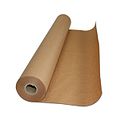Kraft paper
Kraft paper, a durable and versatile material, is widely used in packaging, arts, and various industrial applications. Its name derives from the German word kraft, meaning strength, which reflects the paper's high tensile strength. This article delves into the production, properties, and uses of kraft paper, highlighting its significance in various sectors.
Production
Kraft paper is produced through the Kraft process, a method of pulp production that involves the chemical conversion of wood into wood pulp. The process uses a strong alkaline solution, typically sodium hydroxide and sodium sulfide, to break down the lignin that binds wood fibers together. This method not only yields a strong pulp but also allows for almost complete recovery and reuse of the chemicals involved, making it environmentally friendly compared to other pulping processes.
Properties
Kraft paper is known for its high tensile strength, durability, and resistance to tearing. This strength is attributed to the long fibers of the wood used in the kraft process. Additionally, kraft paper can be produced in various grades, which can be adjusted to suit specific needs, such as increased elasticity or wet strength. It is also relatively porous and has a high elasticity and tear resistance, making it suitable for heavy-duty applications.
Uses
Kraft paper has a wide range of applications, owing to its strength and versatility. It is commonly used in:
- Packaging: As bags, envelopes, wrapping materials, and void fill for shipping. Its durability makes it ideal for carrying heavy items.
- Art and Crafts: Due to its texture and quality, it is popular in scrapbooking, card making, and other craft projects.
- Industrial Applications: In the form of sacks for cement, chemicals, and animal feed, among others, due to its high tear resistance and strength.
- Stationery: Notebooks and journals often use kraft paper for its aesthetic appeal and durability.
Environmental Impact
Kraft paper is considered an environmentally friendly option in the paper industry. The kraft process's efficiency in chemical recovery and reuse, coupled with the use of sustainable forestry practices, minimizes waste and environmental impact. Furthermore, kraft paper is biodegradable and easily recyclable, contributing to its popularity in eco-conscious applications.
Conclusion
Kraft paper's strength, versatility, and environmental benefits make it a staple in various industries. From packaging to crafts, its applications are vast and varied, underscoring its importance in daily life and industrial processes. As sustainability becomes increasingly crucial, kraft paper stands out as a material that combines performance with environmental responsibility.
Transform your life with W8MD's budget GLP-1 injections from $125.
W8MD offers a medical weight loss program to lose weight in Philadelphia. Our physician-supervised medical weight loss provides:
- Most insurances accepted or discounted self-pay rates. We will obtain insurance prior authorizations if needed.
- Generic GLP1 weight loss injections from $125 for the starting dose.
- Also offer prescription weight loss medications including Phentermine, Qsymia, Diethylpropion, Contrave etc.
NYC weight loss doctor appointments
Start your NYC weight loss journey today at our NYC medical weight loss and Philadelphia medical weight loss clinics.
- Call 718-946-5500 to lose weight in NYC or for medical weight loss in Philadelphia 215-676-2334.
- Tags:NYC medical weight loss, Philadelphia lose weight Zepbound NYC, Budget GLP1 weight loss injections, Wegovy Philadelphia, Wegovy NYC, Philadelphia medical weight loss, Brookly weight loss and Wegovy NYC
|
WikiMD's Wellness Encyclopedia |
| Let Food Be Thy Medicine Medicine Thy Food - Hippocrates |
Medical Disclaimer: WikiMD is not a substitute for professional medical advice. The information on WikiMD is provided as an information resource only, may be incorrect, outdated or misleading, and is not to be used or relied on for any diagnostic or treatment purposes. Please consult your health care provider before making any healthcare decisions or for guidance about a specific medical condition. WikiMD expressly disclaims responsibility, and shall have no liability, for any damages, loss, injury, or liability whatsoever suffered as a result of your reliance on the information contained in this site. By visiting this site you agree to the foregoing terms and conditions, which may from time to time be changed or supplemented by WikiMD. If you do not agree to the foregoing terms and conditions, you should not enter or use this site. See full disclaimer.
Credits:Most images are courtesy of Wikimedia commons, and templates, categories Wikipedia, licensed under CC BY SA or similar.
Contributors: Prab R. Tumpati, MD



